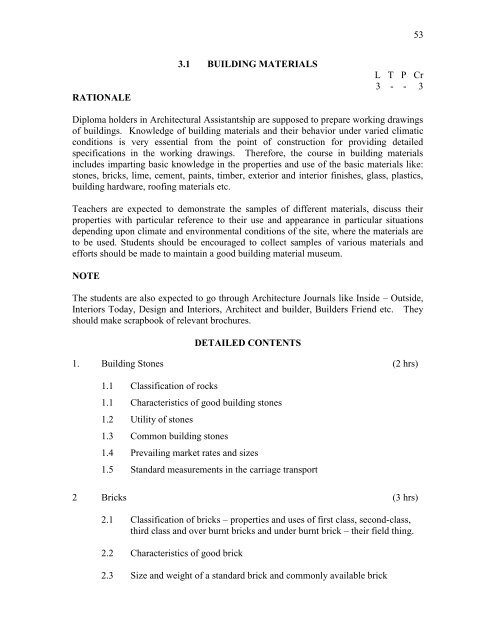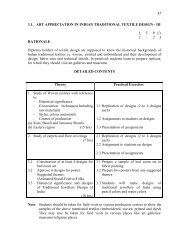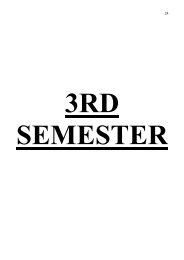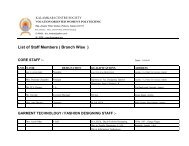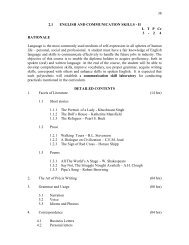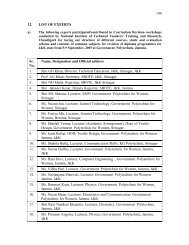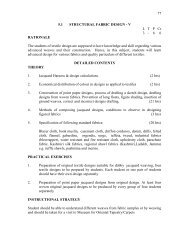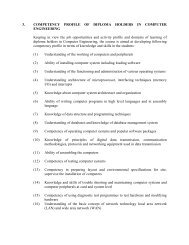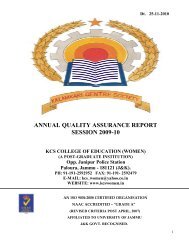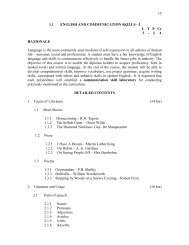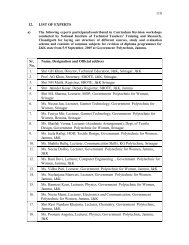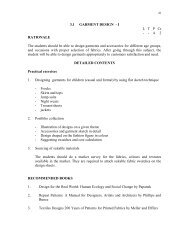53 3.1 BUILDING MATERIALS L T P Cr 3 - - 3 RATIONALE ...
53 3.1 BUILDING MATERIALS L T P Cr 3 - - 3 RATIONALE ...
53 3.1 BUILDING MATERIALS L T P Cr 3 - - 3 RATIONALE ...
You also want an ePaper? Increase the reach of your titles
YUMPU automatically turns print PDFs into web optimized ePapers that Google loves.
<strong>53</strong><br />
<strong>RATIONALE</strong><br />
<strong>3.1</strong> <strong>BUILDING</strong> <strong>MATERIALS</strong><br />
L T P <strong>Cr</strong><br />
3 - - 3<br />
Diploma holders in Architectural Assistantship are supposed to prepare working drawings<br />
of buildings. Knowledge of building materials and their behavior under varied climatic<br />
conditions is very essential from the point of construction for providing detailed<br />
specifications in the working drawings. Therefore, the course in building materials<br />
includes imparting basic knowledge in the properties and use of the basic materials like:<br />
stones, bricks, lime, cement, paints, timber, exterior and interior finishes, glass, plastics,<br />
building hardware, roofing materials etc.<br />
Teachers are expected to demonstrate the samples of different materials, discuss their<br />
properties with particular reference to their use and appearance in particular situations<br />
depending upon climate and environmental conditions of the site, where the materials are<br />
to be used. Students should be encouraged to collect samples of various materials and<br />
efforts should be made to maintain a good building material museum.<br />
NOTE<br />
The students are also expected to go through Architecture Journals like Inside – Outside,<br />
Interiors Today, Design and Interiors, Architect and builder, Builders Friend etc. They<br />
should make scrapbook of relevant brochures.<br />
DETAILED CONTENTS<br />
1. Building Stones (2 hrs)<br />
1.1 Classification of rocks<br />
1.1 Characteristics of good building stones<br />
1.2 Utility of stones<br />
1.3 Common building stones<br />
1.4 Prevailing market rates and sizes<br />
1.5 Standard measurements in the carriage transport<br />
2 Bricks (3 hrs)<br />
2.1 Classification of bricks – properties and uses of first class, second-class,<br />
third class and over burnt bricks and under burnt brick – their field thing.<br />
2.2 Characteristics of good brick<br />
2.3 Size and weight of a standard brick and commonly available brick
54<br />
2.4 Fire bricks, its properties, uses and availability<br />
2.5 Availability of various types of bricks in the market e.g. machine made<br />
bricks, handmade firebricks.<br />
2.6 Transportation cost with different modes of transportation and staking of<br />
bricks on the site<br />
2.7 Introduction of the various types and sizes of brick tiles<br />
3 Lime (1hrs)<br />
<strong>3.1</strong> Classification and uses of lime.<br />
3.2 Setting action of fat lime and hydraulic lime<br />
4 Cement (3 hrs)<br />
4.1 Uses of cement<br />
4.2 Composition of Portland cement<br />
4.3 Setting and hardening of cement<br />
4.4 Types of cement, their properties and uses<br />
4.5 Storage of cement<br />
5. Aggregates (types and uses) (2 hrs)<br />
5.1 Coarse Aggregates<br />
5.2 Fine Aggregates<br />
6. Mortar (3 hrs)<br />
6.1 Functions of Mortar<br />
6.2 Preparation of cement mortar, lime mortar, lime cement mortar and their<br />
uses.<br />
6.3 Proportion of mortar for different building works<br />
7. Concrete (4 hrs)<br />
7.1 Definition of concrete, workability of concrete
55<br />
7.2 Water - Cement Ratio<br />
7.3 Compaction of concrete<br />
7.4 Curing of concrete<br />
7.5 Mixing, placing and uses cement concrete, aggregate - its grading<br />
including Flyash and cement concrete<br />
7.6 Reinforced cement concrete (RCC), M15, M20, M25, RMC<br />
7.7 Necessity of providing reinforcement<br />
7.8 Handling of RCC on site, quality and quantity (field checking) and taking<br />
measurement<br />
8 Timber (3 hrs)<br />
8.1 Characteristics and uses of common Indian timbers i.e. Sal, Deodar, Kail,<br />
Tali, Chir, and Teak and introduction to some locally available timber<br />
8.2 Need for seasoning of timber<br />
8.3 Common methods of Preservation of timber.<br />
8.4 Availability of different types of timber and their comparative market<br />
prices.<br />
9. Plastics (1 hrs)<br />
9.1 Introduction to plastics, their types and uses as materials in building,<br />
industry e.g. flooring, roofing, wall paneling, pipes, doors etc<br />
10. Glass (3 hrs)<br />
Types, sizes, usage, measurement systems and of commonly used glasses in<br />
building construction:<br />
• Sheet glass<br />
• Wired glass<br />
• Laminated safety glass<br />
• Plate glass<br />
• Insulating glass<br />
• Obscured glass<br />
• Coloured glass<br />
• Tinted glass<br />
• Heat absorbing glass<br />
• Glass blocks
56<br />
• Float glass<br />
• Toughened glass<br />
• Structural glazing<br />
11. Introduction to Floor Finishes (4 hrs)<br />
• Terrazzo Tiles and Flooring<br />
• Glazed terracotta and ceramic tiles<br />
• Cement Concrete Tiles<br />
• Marble stone, Kota stone, slate, red sand stone, granite – their tiles and<br />
slabs<br />
• Parquet (Wooden)<br />
• Linoleum tiles and rolls<br />
• PVC<br />
• Heavy duty flooring for industrial building<br />
12. Introduction to wall Finishes (4 hrs)<br />
• Wall board homogeneous<br />
• Laminated fiber boards – types<br />
• Plastic wall tiles – tiles availability<br />
• Wall papers<br />
• Ceramic tiles<br />
• Thermocol<br />
• Foam rubber tiles and rolls<br />
• Textured paint finishes<br />
13. Ceiling Materials (Size, quality, types of finishes, uses, trade names) (4 hrs)<br />
• Hessian cloth<br />
• Gypsum plaster boards, plaster of Paris board<br />
• Plain AC sheets – E board etc.<br />
• Plywood<br />
• Hard Board<br />
• Cellotex<br />
• Fibre Boards<br />
• Fibre glass<br />
• Asbestos tiles<br />
• Thermocol<br />
• Medium density fibre board (MDF)<br />
14. Building hardware (introduction and uses) (2 hrs)<br />
Note: Teacher may show these items to the students in material museum<br />
maintained by the department/market survey.
57<br />
• Tower bolts<br />
• Hinges including concealed hinges<br />
• Door Handles<br />
• Door springs<br />
• Latches<br />
• Floor door stopper/floor springs and magnetic types stoppers<br />
• Fan light pivots<br />
• Mortice lock<br />
• Door closer – including hydraulic types<br />
• Ventilator chains<br />
• Wire gauze<br />
• Magnetic cupboard closers<br />
15. Introduction to roofing Materials (their standard sizes and uses) (4 hrs)<br />
• Asbestos sheets<br />
• GI sheets<br />
• Shingles<br />
• Ferro-cement sheets<br />
• Fibre sheets<br />
• Slates<br />
• Manglore tiles<br />
• Pan tiles<br />
• Corrugated PVC sheets<br />
16. Kitchen and Toilet Fixtures (2 hrs)<br />
(Specifications of kitchen and toilet fittings and fixtures, their popular brand<br />
names, shapes and sizes).<br />
17. Paints (3 hrs)<br />
(Types, uses, coverage area; brand names)<br />
• Water based paints<br />
• Distempers<br />
• Oil based paints and emulsions<br />
• Cement paints<br />
• Acrylic emulsions<br />
• Melamine finishes<br />
• Varnishes<br />
• Spirit polish, wax polish<br />
• Lacquers<br />
• Stucco<br />
• Tar and Bitumen paint<br />
• Glazing putty
58<br />
Note: The study should be supported by market survey of materials with brands, sizes,<br />
rates and availability. An exercise should be conducted to take the students to<br />
building material exhibitions and make them aware of new materials being<br />
launched in market and let them prepare a brief report on the application of new<br />
materials and understand how to chose a material for a specific purpose after<br />
evaluating its availability, cost, performance and elegance etc.<br />
Teachers should demonstrate samples of various materials while imparting<br />
classroom instruction. Teachers may also arrange some field visits to<br />
manufacturing production units and retailer shops like cement, kilns, timber saw<br />
mills and seasoning plants, hardware shops, glass houses etc. Students should be<br />
encouraged to collect samples of various materials and catalogues of<br />
manufacturer. The students may maintain a scrapbook for this purpose. A<br />
museum of building construction, materials may be developed where samples of<br />
latest materials their specifications, characteristics, rates availability (supplier and<br />
relevant codes may be kept) to enhance to level of understanding of the students.<br />
The application of various materials should be shown to students in various<br />
buildings of importance, as reference<br />
INSTRUCTIONAL STRATEGY<br />
This is one of the fundamental subject covering basic building construction and finishing<br />
materials. Teachers should demonstrate samples of various materials while imparting<br />
classroom instruction. Teachers may also arrange some field visits to manufacturing/<br />
production units and retailer shops like cement, kilns, timber saw mills and seasoning<br />
plants, hardware shops, glass houses etc. Students should be encouraged to collect<br />
samples of various materials and catalogues of manufacturer. The students may maintain<br />
a scrapbook for this purpose. A museum of building construction, materials may be<br />
developed where samples of latest materials their specifications, characteristics, rates,<br />
manufacturer (supplier and relevant codes may be kept) to enhance the level of<br />
understanding of the students<br />
RECOMMENDED BOOKS<br />
1. Sharma, SK; and Mathur, GC; "Engineering Materials;" Delhi-Jalandhar, R.<br />
Chand and Co.<br />
2. Surendra Singh; "Engineering Materials;" New Delhi, Vikas Publishing House<br />
Pvt. Ltd.<br />
3. Chowdhuri, N; "Engineering Materials;" Calcutta, Technical Publishers of India.<br />
4. Bahl, SK; "Engineering Materials;" Delhi, Rainbow Book Co.<br />
5. Bahl, SK; "Engineering Materials;" Delhi, Rainbow Book Co.<br />
6. Rangwal “Building Materials”, Standard Publishers.
59<br />
SUGGESTED DISTRIBUTION OF MARKS<br />
Topic No. Time Allotted (Hrs) Marks Allotted (%)<br />
1. 2 4<br />
2. 3 8<br />
3. 1 2<br />
4. 3 8<br />
5. 2 4<br />
6. 3 6<br />
7. 4 8<br />
8. 3 6<br />
9. 1 2<br />
10. 3 6<br />
11 4 8<br />
12. 4 8<br />
13 4 8<br />
14 2 4<br />
15 4 4<br />
16 2 4<br />
17 3 6<br />
Total 48 100
60<br />
<strong>RATIONALE</strong><br />
3.2 <strong>BUILDING</strong> CONSTRUCTION - I<br />
L T P <strong>Cr</strong><br />
- - 6 3<br />
Students of Architectural Assistantship at diploma level are supposed to prepare structural<br />
drawings, working drawings and detailed drawings of various components of buildings.<br />
Also students are expected to design small residential buildings, for this purpose, it is<br />
essential that students are taught various components of building construction comprising<br />
of foundations, super structure, openings, roofs, staircases, floorings and finishing and<br />
other allied building components.<br />
Therefore, the subject of building construction is very important for students undergoing<br />
diploma course in Architectural Assistantship.<br />
Teachers while imparting instructions are expected to show various components to<br />
buildings under construction. Make use of models or other audio-visual media to clarify<br />
the concepts. While preparing drawings, teachers should lay considerable stress on<br />
proportioning, dmensioning, specification writing and printing and composition of<br />
drawing work. Teachers should also lay emphasis on environmental aspects like lighting,<br />
ventilation and orientation of buildings, students should be asked to maintain a sketch<br />
book for recording the observations form site visit. While conducting viva, teachers<br />
should point out specific.<br />
DETAILED CONTENTS<br />
1. Brick work and stone work<br />
‣ Different sizes and types of bricks<br />
‣ 9”, 13½” wall thickness in L-juntions, T-<br />
junctions, cross junction in English Bond<br />
(Flemish bond – introduction only)<br />
‣ Brick jalies and Reinforced brick work<br />
‣ Stone facings and claddings and<br />
classification of masonry<br />
2. Openings in walls<br />
‣ Classification of arches as per shape and<br />
material<br />
‣ Classification of lintels of different<br />
materials, precast and cast-in-situ<br />
1. Drawing of different<br />
shapes and sixes of<br />
bricks<br />
(1 sheet)<br />
2. Plan and elevation of L,<br />
T and X-Junctions of<br />
9”, 13½” thick brick<br />
wall in English Bond<br />
(1 sheet)<br />
3. Jallies<br />
(1 sheet)<br />
4. Drawings of lintels and<br />
arches of various types<br />
(1 sheet)
61<br />
3. Damp Proof course: (DPC)<br />
‣ Sources of dampness and effects of<br />
dampness<br />
‣ Classification as per hardness or rigidity of<br />
material<br />
‣ BIS stipulation of damp proofing<br />
‣ Treatment of building components for<br />
effective damp proofing<br />
4. Foundations<br />
‣ Different types of foundations with<br />
reference of advantage of one over the other<br />
‣ Foundations of different types with<br />
reference to method of construction<br />
5. Doors and windows<br />
‣ Definitions, functions, sizes, location and<br />
classification<br />
‣ Joints<br />
6. Flooring<br />
‣ Constituents and types of floorings for<br />
ground and upper floors<br />
‣ Steel joist and RCC floors<br />
‣ Floor finishes<br />
5. Drawing of spread<br />
foundation and<br />
application of DPC on<br />
spread foundation<br />
(1 sheet)<br />
6. Drawing of different<br />
types of doors with<br />
frames (paneled flush)<br />
showing joints and<br />
fixtures.<br />
(1 sheet)<br />
7. Drawing of different<br />
types wooden windows<br />
(1 sheet)<br />
8. Free hand sketches and<br />
written assignment<br />
Total : 7 sheets<br />
INSTRUCTIONAL STRATEGY<br />
This subject is of practical in nature. While imparting instruction for preparation of<br />
various drawings of different types of buildings and their components, the teacher should<br />
organize demonstration and field/site visits to show various stages, sizes and scales of<br />
operations involved in building construction. The teacher should involve the theoretical<br />
aspects of the instructions to the students before drawings are attempted by the students.<br />
Students may prepare the port-folio of the work done by them throughout the session.<br />
Teacher may also organize viva-voce after each drawing assignment so as to test the level<br />
of understanding of the students about unlying concepts, princples, and procedures.<br />
RECOMMENDED BOOKS<br />
1. Building Construction by WB Mackay<br />
2. Building Construction by SP Bindra and SP Arora
62<br />
3. Building Construction by BC Punmia<br />
4. Building Construction by Sushil Kumar<br />
5. Construction of Buildings (Vol I and II) by Barry<br />
6. Building Construction by VB Sikka<br />
7. Building Construction by Rangwala
63<br />
3.3 BASICS OF INFORMATION TECHNOLOGY<br />
<strong>RATIONALE</strong><br />
L T P <strong>Cr</strong><br />
- - 4 2<br />
Information technology has great influence on all aspects of life. Almost all work places<br />
and living environment are being computerized. In order to prepare diploma holders to<br />
work in these environments, it is essential that they are exposed to various aspects of<br />
information technology such as understanding the concept of information technology and<br />
its scope; operating a computer; use of various tools of MS office; using internet etc. form<br />
the broad competency profile of diploma holders. This exposure will enable the students<br />
to enter their professions with confidence, live in a harmonious way and contribute to the<br />
productivity.<br />
Note:<br />
i) Teaching of theory should be detailed with practical work.<br />
ii) The following topics be kept in mind while doing practical exercises in the<br />
laboratory.<br />
DETAILED CONTENTS<br />
1. Information Technology – its concept and scope<br />
2. Elements of a computer system, its usefulness and applications, block diagram of<br />
a computer, CPU, memory, data – numeric data, alpha numeric data; contents of<br />
a program, processing of data<br />
3. Computer organization, computer hardware and software; primary and secondary<br />
memory: RAM, ROM, PROM etc.<br />
4. Input devices; keyboard, scanner, mouse etc ; output devices ; VDU and Printer,<br />
Plotter<br />
5. Primary and Secondary Storage (Auxiliary Storage), Secondary storage; magnetic<br />
disks – tracks and sectors, optical disk (CD, CD-RW and DVD Memory)<br />
6. Introduction to Operating Systems such as MS-DOS and Windows<br />
7. Introduction to internet, browsing using search engine (like google etc. )<br />
8. Basics of Networking – LAN, WAN, Topologies
64<br />
LIST OF PRACTICALS<br />
1. Given a PC, name its various components and list their functions<br />
2. Identification of various parts of a computer and peripherals<br />
3. Practice in installing a computer system by giving connection<br />
4. DOS Commands (internal / external) e.g. TYPE, REN, DEL, CD, MD, COPY,<br />
TREE, BACKUP<br />
5. Exercises on entering text and data (Typing Practice using any tutor)<br />
6. Features of Windows as an operating system<br />
- Start<br />
- Shutdown and restore<br />
- <strong>Cr</strong>eating and operating on the icons<br />
- Opening closing and sizing the windows<br />
- Using elementary job commands like – creating, saving,<br />
modifying, renaming, finding and deleting a file<br />
- <strong>Cr</strong>eating and operating on a folder<br />
- Changing setting like, date, time color (back ground and fore<br />
ground)<br />
- Using short cuts<br />
- Using on line help<br />
7. MS-Word<br />
- File Management:<br />
Opening, creating and saving a document, locating files, copying contents<br />
in some different file(s), protecting files, Giving password protection for a<br />
file<br />
- Page Set up:<br />
Setting margins, tab setting, ruler, indenting<br />
- Editing a document:<br />
Entering text, Cut, copy, paste using tool- bars<br />
- Formatting a document:<br />
Using different fonts, changing font size and colour, changing the<br />
appearance through bold/ italic/ underlined, highlighting a text, changing<br />
case, using subscript and superscript, using different underline methods<br />
- Aligning of text in a document, justification of document, Inserting bullets<br />
and numbering<br />
- Formatting paragraph, inserting page breaks and column breaks, line<br />
spacing<br />
- Use of headers, footers: Inserting footnote, end note, use of comments<br />
- Inserting date, time, special symbols, importing graphic images, drawing<br />
tools<br />
- Tables and Borders:<br />
<strong>Cr</strong>eating a table, formatting cells, use of different border styles, shading in<br />
tables, merging of cells, partition of cells, inserting and deleting a row in a<br />
table<br />
- Print preview, zoom, page set up, printing options
65<br />
- Using Find, Replace options<br />
- Using Tools like:<br />
Spell checker, help, use of macros, mail merge, thesaurus word content and<br />
statistics, printing envelops and labels<br />
- Using shapes and drawing toolbar,<br />
- Working with more than one window in MS Word,<br />
- How to change the version of the document from one window OS to<br />
another<br />
- Conversion between different text editors, software and MS word<br />
8. MS-Excel<br />
- Starting excel, open worksheet, enter, edit, data, formulae to calculate<br />
values, format data, create chart, printing chart, save worksheet, switching<br />
between different spread sheets<br />
- Menu commands:<br />
<strong>Cr</strong>eate, format charts, organize, manage data, solving problem by<br />
analyzing data, exchange with other applications. Programming with MS-<br />
Excel, getting information while working<br />
- Work books:<br />
Managing workbooks (create, open, close, save), working in work books,<br />
selecting the cells, choosing commands, data entry techniques, formula<br />
creation and links, controlling calculations, working with arrays<br />
- Editing a worksheet, copying, moving cells, pasting, inserting, deletion<br />
cells, rows, columns, find and replace text, numbers of cells, formatting<br />
worksheet<br />
- <strong>Cr</strong>eating a chart:<br />
Working with chart types, changing data in chart, formatting a chart, use<br />
chart to analyze data<br />
- Using a list to organize data, sorting and filtering data in list<br />
9. MS PowerPoint<br />
a) Introduction to PowerPoint<br />
- How to start PowerPoint<br />
- Working environment: concept of toolbars, slide layout, templates<br />
etc.<br />
- Opening a new/existing presentation<br />
- Different views for viewing slides in a presentation: normal, slide<br />
sorter etc.<br />
b) Addition, deletion and saving of slides<br />
e) How to view the slide show?<br />
- Viewing the presentation using slide navigator<br />
- Slide transition<br />
- Animation effects etc.
66<br />
10. Internet and its Applications<br />
a) Log-in to internet<br />
b) Navigation for information seeking on internet<br />
c) Browsing and down loading of information from internet<br />
d) Sending and receiving e-mail<br />
- <strong>Cr</strong>eating a message<br />
- <strong>Cr</strong>eating an address book<br />
- Attaching a file with e-mail message<br />
- Receiving a message<br />
- Deleting a message<br />
3 RECOMMENDED BOOKS<br />
1. Fundamentals of Computer by V . Rajaraman; Prentice Hall of India Pvt. Ltd., New<br />
Delhi<br />
2. Computers Today by SK Basandara, Galgotia Publication Pvt ltd. Daryaganj, New<br />
Delhi.<br />
3. MS-Office 2000 for Everyone by Sanjay Saxena; Vikas Publishing House Pvt. Ltd.,<br />
New Delhi<br />
4. Internet for Every One by Alexis Leon and Mathews Leon; Vikas Publishing House<br />
Pvt. Ltd., Jungpura, New Delhi<br />
5. A First Course in Computer by Sanjay Saxena; Vikas Publishing House Pvt. Ltd.,<br />
Jungpura,New Delhi<br />
6. Mastering Windows 95, BPB Publication, New Delhi<br />
7. Computer Fundamentals by PK Sinha; BPB Publication, New Delhi<br />
8. Fundamentals of Information Technology by Leon and Leon;Vikas Publishing House<br />
Pvt. Ltd., Jungpura, New Delhi<br />
9. On Your Marks - Net…Set…Go… Surviving in an e-world by Anushka Wirasinha,<br />
Prentice Hall of India Pvt. Ltd., New Delhi<br />
10. Learning MS Office XP by Ramesh Bangia, Khanna Book Publishing Co. (P) Ltd.,<br />
New Delhi.<br />
11. Fundamentals of Information Technology by Vipin Arora, Eagle Parkashan, Jalandhar
67<br />
3.4 STRUCTURAL MECHANICS<br />
<strong>RATIONALE</strong><br />
L T P <strong>Cr</strong><br />
4 - - 2<br />
This is a fundamental course. Which covers principles of Applied Mechanics and<br />
Strength of Materials. The course covers force systems, stress strain relationship,<br />
Centroid of Moment of Inertia, Shear force and Bending moment calculations/diagrams<br />
and bending strains in beams.<br />
After going through this course the student shall be able to appreciate the behavior of<br />
different structure systems.<br />
DETAILED CONTENTS<br />
1. Laws of Forces, Moments and their Applications (10 hrs)<br />
1.1 Force, units and characteristics of a force, representation of forces,<br />
coplanar force system, composition and resolution of force, parallelogram<br />
– Triangle - Polygon law of forces<br />
1.2 Resultant of several coplanar concurrent forces. Lami’s Theorem<br />
1.3 Concept of moment, characteristics of a moment, concept of a couple<br />
1.4 Resultant of several coplanar non concurrent parallel / non parallel forces.<br />
1.5 Link polygon (graphical) method for finding resultant of any number of<br />
like or unlike parallel forces<br />
1.6 Equilibrium conditions for bodies under coplanar forces<br />
1.7 Numerical problems bases on above topics<br />
2. Simple stresses and strain<br />
2.1 Introduction- Concepts of direct (simple) stress and strain (10 hrs)<br />
2.2 Hook’s Law<br />
2.3 Elastic Constants and their inter relationships<br />
2.4 Stresses and strains in bars and composite – bars of different materials<br />
2.5 Temperature stresses and Strains<br />
2.6 Stress-Strain Curve for mild steel, yield stress, working stress and Factor<br />
of safety.<br />
3. Centroid and Moment of Inertia (10hrs)<br />
<strong>3.1</strong> Concept of centre of Gravity and Centroid<br />
3.2 Centroid by method of moments of areas for square, rectangular,<br />
triangular, L-shape, T-shape and I shape cross- sections.<br />
3.3 Concept of Moment of Inertia and Radius of Gyration.<br />
3.4 Moment of Inertia of rectangular section.
68<br />
3.5 Parallel axis theorem.<br />
3.6 Moment of inertia of a Triangular section.<br />
3.7 Perpendicular Axis Theorem.<br />
3.8 Moment of Inertia of a Circular section.<br />
4. Bending Moment and Shear Force (16 hrs)<br />
4.1 Concept of a beam, types of supports, loads, beams. Free body diagram.<br />
Calculation of reactions of simply supported, cantilever and over handing<br />
beams subjected to point loads and uniformly distributed loads.<br />
4.2 Concept of bending moment and shear force, BM and SF diagrams for<br />
simply supported, cantilever and over hanging beams subjected to point<br />
loads and uniformly distributed loads only<br />
4.3 Calculation of location and magnitude of Maximum Bending moment and<br />
location of point of contra flexure<br />
5. Bending stresses in Beams (10 hrs)<br />
5.1 Introduction: Bending stresses, simple bending<br />
5.2 Theory of simple bending. Bending Equation (M/I = f/y = E/R) No<br />
derivation<br />
5.3 Position of Neutral Axis.<br />
5.4 Section Modulus. Moment of Resistance. Application of Bending<br />
equation for simply supported beams of rectangular and circular cross<br />
sections<br />
5.5 Factor of safety, Maximum and permissible bending stresses.<br />
6. Analysis of Perfect Frames (8 hrs)<br />
Types of pint jointed frames. Assumptions in computing the forces in<br />
members of a perfect frame. Analysis of perfect frames by method of joints<br />
INSTRUCTIONAL STRATEGY<br />
This subject is introduced so that diploma holder in Architectural Assistantship may<br />
appreciate the concepts and principles of structural design of various elements of building<br />
and are able to apply the knowledge gained through the subject for the design of simple<br />
and small components. Teacher should give simple exercises involving the applications of<br />
various concepts and principles being taught in the subject. Efforts should be made to<br />
prepare tutorial sheets on various topics and students should be encouraged/guided to<br />
solve the tutorial problems independently. Teacher may conduct weekly small quiz<br />
sessions to know the students’ level of understanding and if need be teacher may reinforce<br />
the concepts and principles related to structural behaviour of elements/members of<br />
building components.
69<br />
RECOMMENDED BOOKS<br />
1. Structural Mechanics-VS Prasad-Golgotia Publication Pvt. Ltd., New Delhi.<br />
2. Engineering Mechanics and strength of Materials-Dr RK Bansal –Laxmi<br />
Publications Pvt. Ltd., New Delhi.<br />
3. A text book of Engineering Mechanics- RK Rajput-Dhanpat Rai Publications Pvt.<br />
Ltd., New Delhi<br />
4. Applied Mechanics and Strength of Materials by DN Ghosh<br />
5. Strength of Materials and Mechanics of Structures by Punmia BC<br />
6. Strength of Materials by W Morgan<br />
SUGGESTED DISTRIBUTION OF MARKS<br />
Topic No. Time Allotted (Hrs) Marks Allotted (%)<br />
1. 10 16<br />
2. 10 16<br />
3. 10 16<br />
4. 16 24<br />
5. 10 16<br />
6. 8 12<br />
Total 64 100
70<br />
<strong>RATIONALE</strong><br />
3.5 ARCHITECTURAL DRAWING-III<br />
L T P <strong>Cr</strong><br />
- - 6 3<br />
The students of diploma holder in Architectural Assistantship should have sufficient skills<br />
to draw perspective drawings. Besides this they should also be introduced to sciography<br />
in plans, elevations. They should be given sufficient exercises in rendering of perspective<br />
drawings, so that they are able to perform well in the field/industry.<br />
DETAILED CONTENTS<br />
1. Perspective (Review) (1 sheet)<br />
Introduction to basic terminology (picture plane. Vanishing point. Station<br />
point, cone of vision etc)<br />
Introduction to types- 1 point, 2 point (vanishing point method or measuring<br />
point-method or grid method)<br />
2. Simple Perceptive<br />
• Geometric shapes incorporating all views: cubes, cylinders etc.<br />
• Birds eye view<br />
• Normal eye view<br />
• Worms eye view to clarify concepts (2 sheets)<br />
• 2 point perspective of a given plan (vanishing point and grid method)<br />
(2 sheets)<br />
• 1 point interior perspective of a given plan (drawing room and kitchen)<br />
(2 sheets)<br />
3. Introduction to Sciography-in plans and Elevations.<br />
Basic Geometric shapes (cube, cylinder, cone, pyramid etc). (1 sheet)<br />
Difference between shade and shadow on basic geometric shapes (1 sheet)<br />
Shade and shadow of a basic bldg. (single unit) (1 sheet) (shadows of rounded<br />
bodies, shadows of circular opening projection & cantilevers)<br />
(1 sheet)<br />
4. Introduction to Rendering<br />
Demo from teacher in in different mediums-colour pencils, crayon. Colour<br />
wash, markers etc.<br />
Rendering techniques in pen and inks/ Different colour mediums (2 sheets)<br />
Rendering techniques to show textures such as wood, glass, grass, cloth, water<br />
etc.<br />
Rendering of a given perspective<br />
(1 sheet)<br />
Total no. of sheets = 14
71<br />
INSTRUCTIONAL STRATEGY<br />
This subject is one of the most important, fundamental and practical subject for diploma in<br />
Architectural Assistantship. Teachers should lay emphasis on practical work by the<br />
students and give repetitive exercises in free hand sketching, colouring and rendering like<br />
sketching, shades and shadows, lettering, printing forms and other important component<br />
of architecture. Teachers should lay stress upon perfect line work, properties,<br />
dimentioning, lettering and printing by the students in the classroom. Students should<br />
maintain portfolio of the work done by them throughout the session. Viva voce<br />
examination may be conducted by the teacher on completion of each assignment<br />
RECOMMENDED BOOKS<br />
1. Engineering Drawing by P.S Gill.<br />
2. Building Construction – by Sikka<br />
3. Architectural Grphics – Trancis DK Ching
72<br />
3.6 HISTORY OF ARCHITECTURE - II<br />
<strong>RATIONALE</strong><br />
L T P <strong>Cr</strong><br />
3 - - 3<br />
The course on History of Architecture develops appreciation regarding past and current<br />
trends in the field of architecture. The knowledge of this course will help the students to<br />
understand how political, physical, social, economical and technological change affect the<br />
architecture, materials and construction techniques. The course covers broad topics like:<br />
Islamic Architecture in India, Industrial Revolution, Modern Architecture in Europe and<br />
America, Contemporary/post Independence Architecture in India.<br />
The teacher should try to create interest among the students for this course by organizing<br />
site visits to the local old monuments. Audio-visual aids should also be used to explain<br />
various architectural developments. While imparting instructions, teacher should stress<br />
upon the context of form and space, construction methods structural systems and<br />
materials. The teacher should motivate the students to take general reference for form,<br />
drawings structural solutions and materials from the history, while designing their project.<br />
DETAILED CONTENTS<br />
1. Early Christian Architecture (3 hrs)<br />
Architectural characteristics of St. Peters, Rome.<br />
2. Byzantine Architecture (4 hrs)<br />
Centralized plans and construction methods for dome of St. Sophia Church)<br />
3. Romanesque Architecture :Pisa Cathedral (2 hrs)<br />
4. Gothic ArchitectureArchitectural Characteristics such as Rose Windows, Flying<br />
Buttresses.Notre Dame Paris.<br />
(5 hrs)<br />
5. Renaissance Architecture Early Renaissance Architecture. General architectural<br />
characteristics :Florence cathedral)<br />
(10 hrs)<br />
Late Renaissance: St. Peter’s Rome.<br />
6.. Industrial revolution.Influence of new construction materials and functional needs<br />
,new building types and architectural forms such as bridges, exhibition<br />
halls.(Joseph Paxton’s <strong>Cr</strong>ystal Palace)<br />
(6 hrs)<br />
7. Modern Architecture in Europe and America: (4 hrs.)<br />
Emergence of New building materials (concrete, steel and glass)and their<br />
architectural expression.<br />
8. Philosophy and keywords of Louis Sullivan, Walter Gropius, Frank Lloyd<br />
Wright, Mies Van De Rohe, Le Corbusier.<br />
(14 Hrs)
73<br />
INSTRUCTIONAL STRATEGY<br />
While imparting instructions in this subject, the teachers should organize site visits to the<br />
old monuments and buildings with extra-ordinary architectural features. Experts/Guides<br />
from state and national Archaeology departments may be invited to deliver lectures on the<br />
relevant themes in order to generate interest in the students. Audio-visual material<br />
available on the subject, in the country and abroad, may be procured and presented to the<br />
students from time to time to enrich the quality of classroom institutions. Special<br />
architectural features of some old/historical famous Indian and International buildings<br />
may be presented to the students as case studies. Students may be encouraged to prepare<br />
case studies of at least one famous old/historical building. Web sites, relevant to the<br />
history of architecture may be visited by the teachers and students.<br />
REFERENCE BOOKS<br />
1. Urban Pattern: Arthur B. Gallion.<br />
2. History Builds the Town – Arthur Kohn.<br />
3. World Architecture.<br />
4. Architecture of Towns and Cities – Paul D. Spreinegen<br />
5. Space, Time and Architecture – Sigfried B. Giedeon<br />
6. The new Landscape – Charles Correa<br />
7. Charles Correa – William Curtis<br />
8. After the Masters – Bhatt & Scriver<br />
SUGGESTED DISTRIBUTION OF MARKS<br />
Topic No. Time Allotted (Hrs) Marks Allotted (%)<br />
1. 3 6<br />
2. 4 8<br />
3. 2 4<br />
4. 5 10<br />
5. 10 20<br />
6. 6 12<br />
7. 4 10<br />
8. 14 30<br />
Total 48 100
74<br />
<strong>RATIONALE</strong><br />
3.7 ARCHITECTURAL DESIGN - II<br />
L T P <strong>Cr</strong><br />
2 - 8 6<br />
Diploma holders in Architectural Assistantship find employment with private architects<br />
and also majority of them go for self-employment. Therefore, they are required to develop<br />
aptitude/skills to design residential, commercial and other public buildings.<br />
Teachers while imparting instructions/giving assignments to students are expecting to<br />
teach various elements of design like form function, balance, light of shadow, shape,<br />
plane, volume, line, rhythm, proportions, textures and other such related elements.<br />
Teachers are also expected to show various types of designs of small building to develop<br />
and appreciation for this subject.<br />
Teachers while imparting instructions to the students are requested to familiarize the<br />
students with elements of climatology such as Orientation for Sun And wind, natural<br />
lighting and Sun protection devices. This would form the essential backup for developing<br />
the Architectural design Solutions.<br />
Special Lectures should be delivered to sensitise the students towards seismic- proof<br />
designs as well as those that are friendly towards the physically challenged.<br />
Teachers should also motivate students to maintain sketch book/portfolio of all the<br />
assignments given to the students.<br />
DETAILED CONTENTS<br />
1. Study of spaces and layout of furniture for various activities in small structures<br />
comprising public utilities like Fuel Station, Milk Bar, Florist Kiosk and Guard<br />
House. The study is to presented through plans, elevations, sketches etc. (6 hrs)<br />
2. Design of a single storey structure such as weekend cottage, and the like Milk Bar<br />
etc.<br />
(16 hrs)<br />
Drawings to be produced:<br />
- Site plan<br />
- Plans<br />
- Elevations<br />
- Sections<br />
- Views<br />
- Block Model<br />
3. Time Problem: Furniture layout and section through a given mono-functional<br />
space such as a Café, Nursery classroom etc.<br />
(10 hrs)<br />
NOTE: Relevant theory may be taught along with practical exercises.
75<br />
INSTRUCTIONAL STRATEGY<br />
While imparting instructions in this subject, the teachers should organize site visits to the<br />
old monuments and buildings with extra-ordinary architectural features. Experts/Guides<br />
from state and national Archaeology departments may be invited to deliver lectures on the<br />
relevant themes in order to generate interest in the students. Audio-visual material<br />
available on the subject, in the country and abroad, may be procured and presented to the<br />
students from time to time to enrich the quality of classroom institutions. Special<br />
architectural features of some old/historical famous Indian and International buildings<br />
may be presented to the students as case studies. Students may be encouraged to prepare<br />
case studies of at least one famous old/historical building. Web sites, relevant to the<br />
history of architecture may be visited by the teachers and students.<br />
RECOMMENDED BOOKS<br />
1. Time Saver Standards<br />
2. Manual of Tropical Housing by Otto Koeignsberger<br />
3. Housing,Climate and Comfort by Martin Evans<br />
SUGGESTED DISTRIBUTION OF MARKS<br />
Topic No. Time Allotted (Hrs) Marks Allotted (%)<br />
1. 6 18<br />
2. 16 50<br />
3. 10 32<br />
Total 32 100


